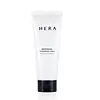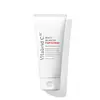What's inside
What's inside
 Key Ingredients
Key Ingredients

 Benefits
Benefits

 Concerns
Concerns

 Ingredients Side-by-side
Ingredients Side-by-side

Glycerin
HumectantWater
Skin ConditioningMyristic Acid
CleansingKaolin
AbrasiveStearic Acid
CleansingPEG-32
HumectantPotassium Hydroxide
BufferingPalmitic Acid
EmollientLauric Acid
CleansingCocamidopropyl Betaine
CleansingGlyceryl Stearate
EmollientPEG-100 Stearate
Olive Oil PEG-8 Esters
EmollientParfum
MaskingSodium Chloride
MaskingZea Mays Starch
AbsorbentMicrocrystalline Cellulose
AbsorbentLactose
HumectantSodium Metaphosphate
BufferingSucrose
HumectantButylene Glycol
HumectantLactic Acid
BufferingAllantoin
Skin ConditioningSodium Benzoate
MaskingCI 77891
Cosmetic ColorantArginine
MaskingThymol Trimethoxycinnamate
AntioxidantNiacinamide
Smoothing3-O-Ethyl Ascorbic Acid
Skin ConditioningCitric Acid
BufferingPropanediol
SolventGlycolic Acid
BufferingTocopheryl Acetate
Antioxidant1,2-Hexanediol
Skin ConditioningCI 77491
Cosmetic ColorantAcrylates/Stearyl Methacrylate Copolymer
Emulsion StabilisingTremella Fuciformis Sporocarp Extract
AntioxidantHyaluronic Acid
HumectantHydrolyzed Vegetable Protein
Skin ConditioningCI 77492
Cosmetic ColorantPaeonia Suffruticosa Extract
Skin ConditioningSodium Hyaluronate
HumectantXanthan Gum
EmulsifyingEthylhexylglycerin
Skin ConditioningDisodium EDTA
Ceramide NP
Skin ConditioningHydrolyzed Hyaluronic Acid
HumectantSodium Hyaluronate Crosspolymer
HumectantPaeonia Albiflora Root Extract
Skin ConditioningSodium Acetylated Hyaluronate
HumectantPaeonia Albiflora Flower Extract
TonicGlycerin, Water, Myristic Acid, Kaolin, Stearic Acid, PEG-32, Potassium Hydroxide, Palmitic Acid, Lauric Acid, Cocamidopropyl Betaine, Glyceryl Stearate, PEG-100 Stearate, Olive Oil PEG-8 Esters, Parfum, Sodium Chloride, Zea Mays Starch, Microcrystalline Cellulose, Lactose, Sodium Metaphosphate, Sucrose, Butylene Glycol, Lactic Acid, Allantoin, Sodium Benzoate, CI 77891, Arginine, Thymol Trimethoxycinnamate, Niacinamide, 3-O-Ethyl Ascorbic Acid, Citric Acid, Propanediol, Glycolic Acid, Tocopheryl Acetate, 1,2-Hexanediol, CI 77491, Acrylates/Stearyl Methacrylate Copolymer, Tremella Fuciformis Sporocarp Extract, Hyaluronic Acid, Hydrolyzed Vegetable Protein, CI 77492, Paeonia Suffruticosa Extract, Sodium Hyaluronate, Xanthan Gum, Ethylhexylglycerin, Disodium EDTA, Ceramide NP, Hydrolyzed Hyaluronic Acid, Sodium Hyaluronate Crosspolymer, Paeonia Albiflora Root Extract, Sodium Acetylated Hyaluronate, Paeonia Albiflora Flower Extract
Propanediol
SolventWater
Skin ConditioningButylene Glycol
HumectantSodium Cocoyl Glycinate
CleansingSodium Cocoyl Isethionate
CleansingGlycerin
HumectantCoco-Glucoside
CleansingLactic Acid
BufferingSodium Cocoyl Glutamate
CleansingKaolin
AbrasiveGlyceryl Stearate
EmollientGlycosyl Trehalose
Emulsion StabilisingMadecassoside
AntioxidantCentella Asiatica Extract
CleansingAsiaticoside
AntioxidantAscorbic Acid
AntioxidantCaryodendron Orinocense Seed Oil
EmollientHydrogenated Starch Hydrolysate
HumectantTocopherol
AntioxidantCaulerpa Lentillifera Extract
Lavandula Angustifolia Oil
MaskingIllite
AbrasiveCarica Papaya Fruit Extract
Skin ConditioningMesembryanthemum Crystallinum Extract
HumectantArtemisia Vulgaris Extract
Skin ConditioningPelargonium Graveolens Flower Oil
MaskingMyrciaria Dubia Fruit Extract
Skin ConditioningNelumbo Nucifera Flower Extract
Skin ConditioningPrunus Mume Fruit Extract
HumectantMyristic Acid
CleansingZinc Oxide
Cosmetic Colorant1,2-Hexanediol
Skin ConditioningTrihydroxystearin
Skin ConditioningLauric Acid
CleansingPalmitic Acid
EmollientCitric Acid
BufferingDisodium EDTA
Caprylyl Glycol
EmollientEthylhexylglycerin
Skin ConditioningPropanediol, Water, Butylene Glycol, Sodium Cocoyl Glycinate, Sodium Cocoyl Isethionate, Glycerin, Coco-Glucoside, Lactic Acid, Sodium Cocoyl Glutamate, Kaolin, Glyceryl Stearate, Glycosyl Trehalose, Madecassoside, Centella Asiatica Extract, Asiaticoside, Ascorbic Acid, Caryodendron Orinocense Seed Oil, Hydrogenated Starch Hydrolysate, Tocopherol, Caulerpa Lentillifera Extract, Lavandula Angustifolia Oil, Illite, Carica Papaya Fruit Extract, Mesembryanthemum Crystallinum Extract, Artemisia Vulgaris Extract, Pelargonium Graveolens Flower Oil, Myrciaria Dubia Fruit Extract, Nelumbo Nucifera Flower Extract, Prunus Mume Fruit Extract, Myristic Acid, Zinc Oxide, 1,2-Hexanediol, Trihydroxystearin, Lauric Acid, Palmitic Acid, Citric Acid, Disodium EDTA, Caprylyl Glycol, Ethylhexylglycerin
Ingredients Explained
These ingredients are found in both products.
Ingredients higher up in an ingredient list are typically present in a larger amount.
1,2-Hexanediol is a synthetic liquid and another multi-functional powerhouse.
It is a:
- Humectant, drawing moisture into the skin
- Emollient, helping to soften skin
- Solvent, dispersing and stabilizing formulas
- Preservative booster, enhancing the antimicrobial activity of other preservatives
Butylene Glycol (or BG) is used within cosmetic products for a few different reasons:
Overall, Butylene Glycol is a safe and well-rounded ingredient that works well with other ingredients.
Though this ingredient works well with most skin types, some people with sensitive skin may experience a reaction such as allergic rashes, closed comedones, or itchiness.
Learn more about Butylene GlycolCitric Acid is an alpha hydroxy acid (AHA) naturally found in citrus fruits like oranges, lemons, and limes.
Like other AHAs, citric acid can exfoliate skin by breaking down the bonds that hold dead skin cells together. This helps reveal smoother and brighter skin underneath.
However, this exfoliating effect only happens at high concentrations (20%) which can be hard to find in cosmetic products.
Due to this, citric acid is usually included in small amounts as a pH adjuster. This helps keep products slightly more acidic and compatible with skin's natural pH.
In skincare formulas, citric acid can:
While it can provide some skin benefits, research shows lactic acid and glycolic acid are generally more effective and less irritating exfoliants.
Most citric acid used in skincare today is made by fermenting sugars (usually from molasses). This synthetic version is identical to the natural citrus form but easier to stabilize and use in formulations.
Read more about some other popular AHA's here:
Learn more about Citric AcidDisodium EDTA plays a role in making products more stable by aiding other preservatives.
It is a chelating agent, meaning it neutralizes metal ions that may be found in a product.
Disodium EDTA is a salt of edetic acid and is found to be safe in cosmetic ingredients.
Learn more about Disodium EDTAEthylhexylglycerin (we can't pronounce this either) is commonly used as a preservative and skin softener. It is derived from glyceryl.
You might see Ethylhexylglycerin often paired with other preservatives such as phenoxyethanol. Ethylhexylglycerin has been found to increase the effectiveness of these other preservatives.
Glycerin is already naturally found in your skin. It helps moisturize and protect your skin.
A study from 2016 found glycerin to be more effective as a humectant than AHAs and hyaluronic acid.
As a humectant, it helps the skin stay hydrated by pulling moisture to your skin. The low molecular weight of glycerin allows it to pull moisture into the deeper layers of your skin.
Hydrated skin improves your skin barrier; Your skin barrier helps protect against irritants and bacteria.
Glycerin has also been found to have antimicrobial and antiviral properties. Due to these properties, glycerin is often used in wound and burn treatments.
In cosmetics, glycerin is usually derived from plants such as soybean or palm. However, it can also be sourced from animals, such as tallow or animal fat.
This ingredient is organic, colorless, odorless, and non-toxic.
Glycerin is the name for this ingredient in American English. British English uses Glycerol/Glycerine.
Learn more about GlycerinGlyceryl Stearate is a mix of glycerin and stearic acid.
It is used to stabilize the mixing of water and oil ingredients. By preventing these ingredients from separating, it can help elongate shelf life. It can also help thicken the product's texture.
As an emollient, it helps soften skin and supports barrier-replenishing ingredients.
In cosmetics, Glyceryl Stearate is often made from vegetable oils or synthetically produced.
This ingredient may not be fungal-acne safe
Fun fact: The human body also creates Glyceryl Stearate naturally.
Learn more about Glyceryl StearateKaolin is a clay. It is used for oil control and to help minimize pores. Like other clays, kaolin has the ability to absorb excess sebum or oil. This can help clean out pores and mattify the skin.
Some types of kaolin may have exfoliating properties. When water is added to kaolin, it becomes a paste with small abrasive particles.
Most kaolin is a white color, but may be pink/orange/red depending on where it comes from.
The name 'kaolin' comes from a Chinese village named 'Gaoling'. Kaolin clay comes from rocks rich in kaolinite. Kaolinite, the mineral, has a silicate layered structure. Kaolinite is formed from chemical weathering of aluminum siilicate minerals.
Besides skincare, kaolin is commonly used to make glossy paper, in ceramics, toothpaste, and as medicine to soothe stomach issues.
Learn more about KaolinLactic Acid is another well-loved alpha hydroxy acid (AHA). It is gentler than glycolic acid but still highly effective.
Its main role is to exfoliate the surface of the skin by loosening the “glue” that holds dead skin cells together. Shedding those old cells leads to smoother, softer, and more even-toned skin.
Because lactic acid molecules are larger than glycolic acid, they don’t penetrate as deeply. This means they’re less likely to sting or irritate, making it a great choice for beginners or those with sensitive skin.
Like glycolic acid, it can:
Lactic acid also acts as a humectant (like hyaluronic acid). It can draw water into the skin to improve hydration and also plays a role in the skin's natural moisturizing factor (NMF) in the form of sodium lactate.
Studies show it can boost ceramide production to strengthen the skin barrier and even help balance the skin’s microbiome.
To get results, choose products with a pH between 3-4.
Lower strengths (5-12%) focus on surface exfoliation; higher strengths (12% and up) can reach deeper in the dermis (deeper, supportive layer) to improve skin texture and firmness over time.
Though it was originally derived from milk, most modern lactic acid used in skincare is vegan. It is made through non-dairy fermentation to create a bio-identical and stable form suitable for all formulations.
When lactic acid shows up near the end of an ingredient list, it usually means the brand added just a tiny amount to adjust the product’s pH.
Legend has it that Cleopatra used to bathe in sour milk to help reduce wrinkles.
Lactic acid is truly a gentle multitasker: it exfoliates, hydrates, strengthens, and brightens. It's a great ingredient for giving your skin a smooth, glowing, and healthy look without the harshness of stronger acids.
Read more about some other popular AHA's here:
Learn more about Lactic AcidLauric Acid is a fatty acid or lipid. About half of fatty acids in coconut oil is lauric acid.
This ingredient helps hydrate and sooth skin. As a humectant, it helps trap moisture. It also aids in cleaning and enhancing the texture of products.
Lauric acid may not be Malassezia folliculitis, or fungal acne, safe.
Learn more about Lauric AcidMyristic Acid is a saturated fatty acid. It is naturally found in milk fat. Other sources include palm oil, coconut oil, and butter fat.
Myristic Acid is an emulsifer and cleanser. As an emulsifer, it stabilizes a product by preventing ingredients from separating. Myristic Acid helps clean your skin by acting as a surfactant. It tends to gather oil and dirt on your skin to be easily rinsed away.
One study from 2021 found Myristic Acid to have anti-inflammatory properties.
Learn more about Myristic AcidPalmitic Acid is a fatty acid naturally found in our skin and in many plant and animal sources. In cosmetics, it is usually derived from palm oil. It serves many purposes in skincare, acting as a cleanser, emollient, and emulsifier.
As an emollient, palmitic acid helps soften and smooth the skin by preventing water loss. In cleansers, it helps remove oil and dirt while creating foam.
Its emulsifying properties help stabilize products by keeping water and oil-based ingredients from separating.
This may not be suitable for fungal acne-prone skin, as fatty acids like this can sometimes trigger breakouts in sensitive individuals.
Learn more about Palmitic AcidPropanediol is an all-star ingredient. It softens, hydrates, and smooths the skin.
It’s often used to:
Propanediol is not likely to cause sensitivity and considered safe to use. It is derived from corn or petroleum with a clear color and no scent.
Learn more about PropanediolWater. It's the most common cosmetic ingredient of all. You'll usually see it at the top of ingredient lists, meaning that it makes up the largest part of the product.
So why is it so popular? Water most often acts as a solvent - this means that it helps dissolve other ingredients into the formulation.
You'll also recognize water as that liquid we all need to stay alive. If you see this, drink a glass of water. Stay hydrated!
Learn more about Water